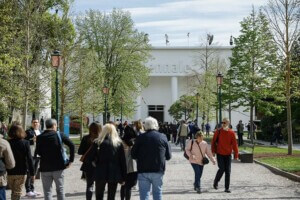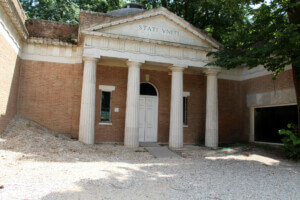After a subdued pandemic iteration, the International Architecture Exhibition at La Biennale di Venezia returns with a strong 18th version curated by Lesley Lokko, the Ghanaian Scottish architectural academic, educator, and novelist. Lokko is the founder of the African Futures Institute and themed the biennale to examine Africa as the laboratory of the future.
The exhibition, which focuses on decolonization and decarbonization organized in six parts, offers a powerful sweep of architectural talent from across the planet. The work on view is materially rich and expansive in its imaginings. It welcomes viewers into an expert understanding of overlooked histories and showcases architecture’s capacity to project ideas into space using many forms of media. Seen from a North American perspective, the work transcends the contemporary feeling of emergency to arrive at a deeper level of personal exploration and community engagement. Rather than bottling up the state of architectural discourse today, this version of the Venice Architecture Biennale succeeds in showing us where we could be headed.

Lokko is the first person of African descent and the fourth woman to curate the architecture biennale. (Architecture still lags a bit behind art: The first African curator of the art biennale was Okwui Enwezor who curated the main show, All the World’s Futures, in 2015.) Before even setting foot in Venice, Lokko’s intentions are clear from numbers alone: Of the 89 participants, more than 50 percent are from Africa or identify as part of the African diaspora. Gender representation is split about evenly, and the average age of participants is 43, lower than in prior showings. Nearly half are educators and work in small practices of five or fewer people. Updating the statistics of a profession that still skews older and whiter means that a host of new contributors are showing work that the world should appreciate. The message is clear. As Lokko wrote, “The balance has shifted. Things fall apart. The centre can no longer hold.”
Lokko’s Force Majeure display takes over the main pavilion of La Biennale. It begins outside, with the addition of a canopy to the whitewashed facade: A set of red struts supports a roof of cut pieces of corrugated metal above a recessed area painted a darker ruby tone. The addition sets the tone for a potent mix of contextual attunement transformed by action. Inside, the grid of galleries hosts work by 16 participants selected by Lokko to show us the way forward.
Much of the work is impressive: Olalekan Jeyifous’s ACE/AAP fills the large, upper-level gallery. It imagines a network of renewable, green technologies (the African Conservation Effort, or ACE) that enable a rapid transit system (the All-Africa Protoport, or AAP) to move passengers between diasporic sites. The worldmaking, set in the year 1X72, delivers complex infographics and elegant, Midjourney-esque rendered portraits of users. The space is set up like a transit lounge with deep plywood benches and yellow sculptures. On screen, a video scrolls through imagined transit sequences, news simulations, and job advertisements, with transitions that mimic the split-flap display once seen in airports and train stations. The scene is retro-futuristic and stylish, well deserving of its commendation with the Silver Lion award for a promising young participant.

Elsewhere, Native(s) Lifeways fills a gallery and the open-air Scarpa garden with research on and designs for the Black cultural landscapes of Charleston, South Carolina, and the Low Country by Hood Design Studio. A wood-framed pavilion by Sean Canty is bathed in colored light; it seems aloof until one realizes it includes studies of two vernacular buildings—a home and a juke joint—built by his great-grandfather, Edgar. Francis Kéré’s Counteract returns to his origins through a curvy wall augmented by clay pots, largescale photography, and painted signage. (Nearby, SOFTLAB@PSU, led by Felecia Davis, installed Textural Threshold Hair Salon: Dreadlock, which was supported in part by a contribution from AN.) Other highlights include Mediterranean Queendoms, a woven tapestry by New South included as one of Lokko’s Guests from the Future, and a room of wall drawings in chalk by atelier masōmī, from Niamey, Niger.

The arrangement means that some pieces were inevitably shunted to faraway galleries, and the rush to the finish line left some technical issues to be fixed, including an opening video in the round on the work of Adjaye Associates that was at times on the fritz. The awkward, dark room below Jeyifous’s staging was given over in part to a video from Theaster Gates that reflects on ten years convening the Black Artists Retreat in Chicago. Though moving, it isn’t as compelling as two other works by Gates on view simultaneously in Venice: The Flood, made for Fondazione Prada’s exhibition Everybody Talks About the Weather, in which performers sing and act out a flood; and Gone Are the Days of Shelter and Martyr, a 2014 film in which Black monks perform in a Catholic church in Chicago destined for demolition, showing as part of Icônes at the Pinault Collection’s Punta della Dogana.
Dangerous Liaisons, installed in the Arsenale’s long Corderie interior, expands Lokko’s vision to a wider set of practitioners and projects. The opening spatial sequence disassociates attendees from the outside world: One encounters a bath of blue light, a mirrored octagon with screens rotating through quotes, and then a tall screen sports a piece by spoken-word artist Rhael “LionHeart” Cape, that asks people to imagine “a view that wasn’t prescribed to you” and characterizes architecture as “organized dysfunction.” For Lokko, LionHeart is “architecture’s first poet laureate.”


The movement ferries you toward Griot by Studio Barnes, which centers a 6,000-pound, solid Identity Column carved from black Spanish Marquina marble between drawings and masks. While the latter items deal with the main themes of appropriation, Black bodies, and columnar disorder through projective means, the former is physical in its realignment of Western architectural history to include Blackness as a central component. In an interview for Mas Context, Germane Barnes said that the column “shows just how heavy it means to be Black.”

What follows extends the theme, with some variation along the way. Aequare: the Future that Never Was, a three-part project by Twenty Nine Studio/Sammy Baloji , investigates the displacement of precolonial society during Belgium’s colonial possession of the Democratic Republic of the Congo. The piece includes a film made from archival imagery and Baloji’s field research, archival documents from agronomists and architects of the Belgian government, and, most powerfully, research on the Belgian architect Henry Lacoste and his design for the Belgian Pavilion at the 1935 World Fair. Never built, it is materialized here in a model made of copper and brass. Baloji, a photographer, also contributed a second project completed with architect Gloria Cabral and art historian Cécile Fromont that compresses mining detritus and scraps of Venetian glass into a tessellated wall supported by scaffolding.


Other highlights include further moments of 1:1 construction. AD—WO’s Ghebbi, an Amharic word that denotes a walled territory, is a frontal threshold that one passes through en route through the show. It is structured in zip-tied bamboo and finished in corrugated metal and blue tarp, which is cut and rolled up to reveal photographs of ghebbis in Addis Ababa by Ethiopian photographer Tsion Haileselassie. The projects pile up through the long Corderie, culminating in a video by Israeli filmmaker Amos Gitai that sets his 1980 film House, about the expansion of a home in Jerusalem by Palestinian workers, against footage from a new play that transposes the story to the stage.

Broken into sequences punctuated by films or atmospheric pieces, the Arsenale’s Corderie is stocked with impressive work and research, pieces serving as curatorial “spacers” between more intense arrangements. Additional North American practices make impressive contributions. Under the Gender & Geography theme for the curator’s Special Projects, J. Yolande Daniels installed The BLACK City Astrolabe: A Constellation of African Diasporic Women, a tunnel-like mapping device. Nearby, under the Mnemonic heading, Höweler + Yoon and Studio& (Mabel O. Wilson) give voice to the archives at the University of Virginia, which informed their work on the Memorial to Enslaved Laborers on the school’s campus. In the main space, Chicago’s Sweet Water Foundation documents acts of furniture-making (the outfit, cofounded by Emmanuel Pratt, also built a meeting house at Forte Marghera, across the lagoon on the mainland), and Low Design Office exhibits Enviromolecular, the latest version of its work with participatory construction in Ghana.
Across the two sites, the best work begins from narrative but makes its impact through material operations such as weavings, textiles, fabrics, carvings, and models. Videos were also a favored format, though it’s hard to sit still for an extended time here. Thankfully, the book-on-the- wall era of architectural exhibitions is gone, now replaced by the presence of enigmatic, crafted objects. (Even the establishing wall texts were problematic: Their low-contrast vinyl installation, though chic, was hard to read, as George Kafka noted in his review for eflux.) Commentary is extruded through process, not form or declaration, which means the show’s pieces are felt not through rational analysis but instead bodily absorption: Lives and histories have been embedded into media, and you feel things in response. The fact that most of the work comes from small practices means that the difficulties of larger offices (where most architects work) and the attendant political baggage is set aside in preference for individual voices to speak. For the first Venice architecture biennale to center Africa, the tone could have rightfully been one of upset and demonstration against the state of the continent after centuries of exploitation. Instead, the work soars, transmuting human experiences into offerings that vibrate with life.

Thandi Loewenson’s contribution, The Uhuru Catalogues, is an example of this conversion: A series of industrial graphite tiles are etched with murals that image sites of African liberation. Not just a medium to be applied onto paper, the graphite becomes a substrate that thickens with significance: The material is refined to create batteries, largely used in the Global North. Loewenson hails from Zimbabwe, which is the largest producer of lithium in Africa; this knowledge layers the topics of postcolonial extraction and climate justice into the already-compelling artifacts. This isn’t to say that “critical” work is absent from the show. In the Corderie, Andrés Jaque’s Office for Political Innovation presents Xholobeni Yards: Titanium and the Planetary Making of Shininess/Dustiness. The installation links activists from Africa with a range of experts to critique architecture’s addiction to shiny facades, as seen in the clear glass of Hudson Yards, which is made possible through titanium-based coatings whose mining has caused Xholobeni, South Africa, to become a dust bowl. Jaque writes that the installation “mobilizes architecture’s capacity to allow human bodies to feel the violence other bodies sense through human extractivism.” The operatic stage set of models lights up to the sound of Jaque’s voice, which unpacks our responsibility for more-than-human awareness.
Close by, an expert project by Amsterdam-based Killing Architects documents the operations of detention camps in Xinjiang, which since 2016 have allegedly held over a million Muslim minorities. The research, originally published in the now-shuttered BuzzFeed News, is based on satellite imagery and interviews with ex-prisoners and results in a film, detailed drawings, and wall-sized illustrations about the layout of the facilities. It is an astounding project for which architect Alison Killing was awarded a Pulitzer Prize in 2021, but it was offensive enough that China, after opening its own national pavilion, pulled out of the biennale in protest. (National leadership in Beijing refuses to acknowledge the documented human rights abuses, while Killing’s team “stands by [their] reporting.”)

Even celebrated participants aren’t immune to drama. Adjaye Associates likely appears the most in the biennale, with four separate contributions, including Kwae, a blackened-timber structure that hollows out a triangular prism, prominently set on a dock outside the Arsenale. The office actually has a fifth effort on view in Venice if you count its appearance in an independently organized exhibition about NEOM, which took over two floors of an abbey in Dorsoduro. The project has been criticized widely for its greenwashing. Here, Adjaye Associates’ proposal for a portion of The Line, one component of NEOM, is seen in a large model and renderings. The exhibition evidences that The Line is now under construction, but just what it will look like remains unclear.

Whatever structural critique is handled indirectly in the main exhibitions lands with full force in the national pavilions, many of which are successful outings. The best ones advance criticism head-on. The Netherlands is presenting drawings of architect Carlijn Kingma that illustrate the flow of money through society. Latvia has realized a satirical supermarket that turns the pieces from the last ten biennales into consumer projects to be plucked from cardboard shelves, a reminder that even cultural endeavors do not escape commodification. The Korean Pavilion stages a game show and speculations that explore how people might cooperate in 2086, when, it is thought, the population will peak. Germany collected the refuse from last year’s art biennale and organized it into a handsome, inventoried warehouse. And Canada launched the protest-soaked Not for Sale!, an investigation into the country’s housing crisis by Architects Against Housing Alienation. Austria, whose pavilion backs up to the wall of the Giardini, attempted to build a bridge to allow free access to the grounds. Venice officials shut down the idea, so the show includes a half-bridge built from scaffolding and the research of local activists about the growing footprint of La Biennale across the city.


The move toward open access aligned with the latest version of the Unfolding Pavilion, curated by Daniel Tudor Munteanu and Davide Tommaso Ferrando (who also joined AN’s Critically Yours symposium), which publicized the two locations where one could freely access the walled Giardini sans 25€ entry fee. The authorities soon removed the unauthorized interventions. By the end of the vernissage, a healthy skepticism about the affair sets in, along with sleep deprivation and the summed effects of too many spritzes. How radical can an organization be when its lead sponsors are Rolex and Bloomberg Philanthropies? The event promises its own carbon neutrality, but what about the emissions of its jet-set attendees? Thankfully, the work amassed by Lokko remains after the crowds disperse; I toured the full biennale a second time the following week and found it productive to have more quiet to linger within. The terror of Venice is that there is so much to see; the benefit is that what you see sticks with you.

Other national pavilions again work through material means. The U.S. pavilion explores plastics through the work of five artists and designers who use the petroleum product in thoughtful ways. At the Belgian pavilion, organizers grew tiles made of mycelium and mounted them on a wood armature. Within the Nordic countries pavilion, a version of Joar Nango’s Girjegumpi The Sámi Architecture Library shares its stacks amid raw wood structures finished with animal pelts. Finland mounted an ode to the huussi (composting toilet) and call for the death of its flushing cousin. And Bahrain considers the value of water through a setup that condenses vapor into liquid that then drips down to planters.
Still others directly address their actual buildings: Switzerland literally deconstructs the wall between its Bruno Giacometti–designed pavilion and its neighbor, the Venezuelan gallery designed by Carlo Scarpa, turning the freed bricks into benches. Japan’s is a love letter to its own concrete pavilion, designed by Takamasa Yosizaka. Estonia set up shop in a rented apartment near the Arsenale to explore the gap between a home’s role as investment and platform for living.
Politics still enter the picture. Though almost 17 percent of the world’s population lives in Africa, only three countries from the continent have official national presences: South Africa, Egypt, and Niger. India, the planet’s most populous country, isn’t participating, and Russia’s freestanding pavilion has remained dark. (It also wasn’t used during last year’s art biennale, when its curators resigned in an act of protest.) Ukraine, meanwhile, delivers a two-part pavilion: A low, dark, fabric-clad room in the Arsenale complex and a grassy earthwork in the Giardini that bowls into a narrow amphitheater; both are places for telling stories.
The awards jury heeded the curator’s priorities when making its selections: The Golden Lion went to Terra, Brazil’s pavilion curated by Gabriela de Matos and Paulo Tavares, which seeks to reconnect Indigenous knowledge back to the soil; and DAAR, led by Alessandro Petti and Sandi Hilal, for their work on decolonizing architecture in Palestine and Europe.

In remarks during the opening press conference, Lokko addressed the crusty complaint that the overall affair “stopped short of architecture,” a common refrain for those who don’t see the value of architecture welcoming those it has excluded, either de jure or de facto. Lokko countered that “it is our conventional understanding of architecture that stops short.” (Patrik Schumacher had a similar pan; he posted on Facebook that the participants used their spotlight for “documentary-style intellectual-artistic allusions to moral issues, garnished with pretentious critical-speak, of course without ever taking the risk of really taking up an explicit position or offering constructive proposal.”) Elsewhere, Lokko said “the intention is not to replace, but to augment. To expand, not to contract. To add, not subtract.” The uplift of nonwhite practitioners is not a substitution or stunt but an ongoing, long-overdue broadening of who gets to make architecture as we renovate the foundations of our shared world.
Regime change begins at home, but its difficulty sets in when you take stock of your local conditions: With all this goodwill in the air, why aren’t things improving faster? In a wall text, Lokko wrote that “the survival of the profession will ultimately depend on our ability to adapt to changing circumstances, intelligently, thoughtfully, ethically, and resourcefully.” Other routes into the future exist; Lokko’s biennale shows us a way forward.










